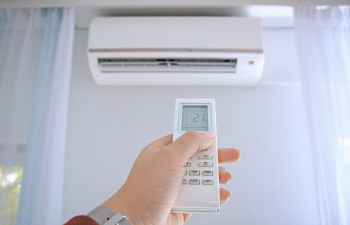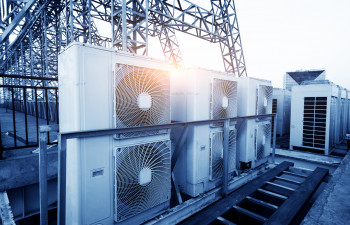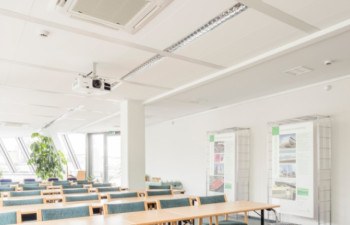Thermodynamics describes the action of heat and other types of energy, and the relationship between them. It is a topic that seems a little daunting at first glance. However, if you understand the theory of thermodynamics in Heating, Ventilating and Air Conditioning (HVAC) systems, you’ll be able to immediately grasp how and why systems work, and how they are best applied.
6 basics of heat transfer
To understand the principles of thermodynamics we must first comprehend six concepts around heat and heat transfer.
1) Cold means an absence of heat. To make something cold, you take heat away.
2) Heat and temperature are different things:
- Heat is the flow of energy from one object, system or place to another.
- Temperature measures the internal kinetic energy of an object.
3) Heat naturally moves from a hot area to a cooler one.
4) Heat moves in three ways.
- Conduction is the transfer of heat from one object to another via direct contact.
- Convection is the transfer of heat from an object to the environment, through a gas or liquid, from a high temperature to a low temperature.
- Radiation is the transfer of heat via electromagnetic radiation.
5) A phase change is when something changes from one state to another e.g. ice (solid) melts into water (liquid) which can evaporate into a steam (gas).
6) The bigger the temperature difference between two mediums, the quicker the rate of heat transfer.
The laws of thermodynamics
The good news is that you don’t need a science degree to understand how HVAC systems work. There are four laws of thermodynamics in total; the zeroth, first, second and third laws. The zeroth law was the last law to be discovered, but it underpins the other three laws, hence its name and order of precedence.
While the zeroth and first laws are easy to understand, the second and third laws relate to something called entropy, which is the measure of the disorder of a system. While that all sounds really complex, entropy is a measure of how spread out energy is. Energy is useful when it is concentrated together, but when it becomes disbursed and spreads out, it’s not useful e.g. if we burn a log, the energy concentrated within the log is released to the surrounding air. That energy is still there, (in the atmosphere) however it is now of no use.
The zeroth law of thermodynamics
What it says: The zeroth law states that if two thermodynamic systems are each in thermal equilibrium with a third system, then they are in thermal equilibrium with each other.
What it means: If two objects are the same temperature they will not exchange heat.
Example: Food and drink in a fridge will be the same temperature as the air in the fridge. All are in thermal equilibrium and there is no heat transfer between substances.
First law of thermodynamics
What it says: The first law states that energy can neither be created nor destroyed.
What it means: Known also as the Law of Conservation of Energy, it explains that energy can only be transferred or changed from one form to another.
Example: An electric oven will convert electricity into heat energy. A 100 units of electrical energy will convert into 100 units of heat energy to cook your food.
Second law of thermodynamics
What it says: The second law states entropy of any isolated system will always increase over time.
What it means: Energy is always spreading out. Heat will always move from warmer area to a cooler area, but it will not flow spontaneously from cold to hot.
Example: The moment you remove a freshly cooked meal from an oven it will loose heat. Heat moves from the hot food to the cooler plate, and the cooler air around it.
Third law of thermodynamics
What it say: As temperature approaches absolute zero*, the entropy of a system approaches a constant minimum.
What it means: As you reach absolute zero, no heat energy remains. Heat cannot transfer to another substance and as there is no energy to spread out. Entropy therefore reaches a point of zero also.
Example: The molecules in steam move around quickly and it has high entropy. If the steam cools below 100oC it will undergo a phase change from gas to liquid water. Water has a lower movement of molecules compared to steam and a lower entropy. Cool the water below 0oC and it undergoes another phase change from a liquid to solid ice. The movement of molecules declines further, as does the entropy. If this ice is cooled all the way to absolute zero, the entropy will become zero too.
*0o Kelvin, -273.15oC or -459.67oF.
We’ve learnt that:
- Different types of energy can be converted into each other.
- Heat naturally moves from a hot area to a cooler one, but if objects are the same temperature, no heat will be transferred.
- The amount of useful energy a substance loses is affected by temperature.
By using these principals in the thermodynamic cycle, the movement of heat can be controlled and used to our advantage.
Refrigerant and the thermodynamic cycle
Refrigerant is an extremely useful substance. It has a low boiling point and can be easily manipulated to absorb and release heat. When you increase the pressure on refrigerant, its temperature and internal kinetic activity will likewise increase. When you decrease the pressure on refrigerant, its temperature and internal kinetic energy will fall.
In HVAC systems, refrigerant will circulate through components that not only change its pressure and temperate, but also its physical state. Refrigerant will phase change from a liquid to a gas and vice versa, absorbing and releasing heat as it does.
Thermodynamics in chillers and heat pump systems
The thermodynamic cycle for chiller and heat pump systems is exactly the same. The cycle can be used for heating or cooling, using a vapor-compression cycle. In a simple system, this consists of four primary components:
Compressor: The compressor is the heart of the system and drives the entire refrigeration process. Low-pressure refrigerant gas (saturated vapour) enters the compressor and is compressed into a high-pressure, heated gas (superheated vapour). This hot refrigerant gas then flows towards the next element in the system, which is the condenser.
Condenser: The condenser is a heat exchanger which also changes the state of the refrigerant from gas to liquid. In the condenser, the superheated vapour is condensed into a high-pressure liquid (saturated liquid), when it exchanges unwanted heat via either water or air. This state change releases latent heat, and sub-cools the refrigerant.
In the cooling process in a chiller system, the condenser acts as a heat exchanger to release unwanted heat to the atmosphere via air or water.
In the heating process in a heat pump system, this heat is exchanged for use within the heating and hot water circuits of the building.
Expansion valve: The high-pressure liquid refrigerant then passes through an expansion valve. This reduces pressure, which reduces temperature, resulting in a cool, low-pressure refrigerant liquid.
Evaporator: The cool, low-pressure liquid refrigerant enters the evaporator. Like the condenser, the evaporator is also a heat exchanger which initiates a state change in the refrigerant. The refrigerant absorbs heat from either air or water, which causes it to boil and evaporate into a low-pressure gas (saturated vapour). This state change absorbs heat, leaving the air or water cooled.
The low pressure gas moves from the evaporator into the compressor and the cycle starts again.
In the cooling process in a chiller system, heat is exchanged between the refrigerant in the evaporator and the cooling circuits (chilled water loop).
In the heating process in a heat pump system, heat is exchanged between the refrigerant and ambient air or water.
Hopefully you now have a better understanding of the thermodynamics of heat pumps and chiller systems. But before you go there’s one more thing you should know, and that’s how to choose the best HVAC product for your requirements.
The benefits of certification
Did you know that certification enables you to compare products objectively to make an informed decision? Benefits of choosing a certified product include:
- The product performance is evaluated according to the same criteria, and the results are expressed in the same unit of measurement, regardless of the country where the products are manufactured or marketed
- A certified product has its performance verified by an impartial, independent and competent accredited body
- Certified products comply with standards
- A product whose performance is certified will work according to the specifications stated by the manufacturer.
If you want to view and compare certified products such as chillers and heat pumps, visit our certified product directory.






